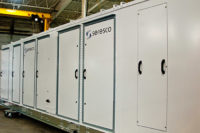The retrofit of a 25-yr-old conventional indoor city recreation center proved to be a psychometrics and logistics challenge, according to the project’s engineer and mechanical contractor. The goal was to take the existing facility and create the new Kanata Leisure & Fitness Centre Wave Pool in Kanata, Ontario, featuring a wave pool, children’s pool, water slide, and spa.
Meeting the engineering challenge and creating the HVAC systems solution for the $500,000 retrofit was Goodkey Weedmark & Associates Ltd. of Ottawa, Ontario, and its design team of Steven Hamilton, P.Eng., associate partner; and Andre Bogdanowicz, P.Eng., principal; and mechanical contractor for T.P. Crawford in Gloucester, Ontario.
The agitation of water from a two-story water slide, spray fountains, a 24- by 9.8-ft 100°F whirlpool spa, plus a 131- by 43-ft wave pool, requires a moisture removal capacity of 500 lbs/hr. Consequently, the new dehumidifier, which replaced two existing dehumidifiers and an air handler, required more capacity but needed to fit in a cramped mechanical room with no shipping door access or adjacent space for expansion.
Instead of specifying two drop-in replacements, Goodkey Weedmark saved Kanata tens of thousands of dollars in rigging, installation labor, and facility downtime by specifying one large Protocol NP-Series pool dehumidification unit custom-manufactured by Seresco Technologies. Goodkey Weedmark also specified the dehumidifier for space air conditioning, which the original facility’s design didn’t include.
T.P. Crawford’s main job challenge was rigging the unit through the mechanical room’s outdoor air louver, which was enlarged for more access. Regardless of the larger opening, Seresco still had to factory-assemble the dehumidifier for testing and disassemble to three 8-ft-long sections for shipping and rigging, which T.P. Crawford then assembled and installed inside the mechanical room.
Reducing refrigerant dependence was another accomplishment in the HVAC design. The Protocol dehumidifier was designed to use 75% less refrigerant than a conventional direct expansion (DX) dehumidifier, but without a performance loss. Instead, the system uses non-toxic propylene glycol for heat rejection to outdoor dry coolers and supplants nearly 700 lbs of toxic refrigerants. The NP-Series has a 25% refrigerant charge of 160 lbs, but it’s self-contained within the refrigeration circuit and is less susceptible to leaks because it’s factory-sealed, charged, and tested.
The refrigeration circuit transfers heat via a heat exchanger to the glycol circuit. Conventional dehumidifiers using 100% refrigerant are susceptible to leaks because the long piping runs to outdoor condensers are field-installed and more susceptible to joint and condensing coil leaks. When in a vaporized state, refrigerants exit a leaking system’s piping through microscopic leak holes and contaminate the atmosphere. Glycol, on the other hand, is non-toxic and environmentally friendlier than refrigerants such as R-22 and the currently popular R-410A. Consequently, the expected price rise during R-410A’s anticipated future phase-out will have less of an effect on Kanata’s maintenance costs throughout the dehumidifier’s lifecycle.
Goodkey Weedmark also specified several dehumidifier options that will provide operational savings over the equipment’s lifecycle. Heat recovery from the refrigeration circuit is used to supply the majority of pool water heating. Exhaust air heat recovery pre-heats outdoor air. Direct drive fans save up to 20% more energy versus conventional belt-driven fans. The dehumidifier also performs space heating/cooling as well as dehumidification and free pool water heating.
Goodkey Weedmark upgraded the pool water circulation system with a 5-hp pump and 857-kWh heat exchanger, both manufactured by Bell & Gossett.
“The many dehumidifier options require higher upfront capital equipment costs versus a bare-bones model that just dehumidifies, however city officials are committed to increasing facility sustainability and saving hundreds of thousands of dollars in total energy costs in the long term on retrofit projects,” said Hamilton.
Since the dehumidifier was designed to provide the center with its first air conditioning, Hamilton saved the project additional money by reusing the existing ductwork and distributing the air more efficiently with directional supply grilles by Metalaire.
Kanata officials were also concerned about improving IAQ. Goodkey Weedmark responded by increasing air volume by 20% and adding more air changes per hour. The new dehumidifier was also specified with a purge option that expedites a purge of all indoor air in only eight minutes if chloramines become excessive or after periodic water chemistry shock treatments.
The IAQ improvements were critical to the project’s success since the original dehumidifiers didn’t operate to the manufacturer’s specifications and were also undersized for the original design, according to Hamilton.
For Goodkey Weedmark, the KLFCWP was a challenging retrofit, but resulted in an older circa 1980’s natatorium that now boasts state-of-the-art IAQ.








